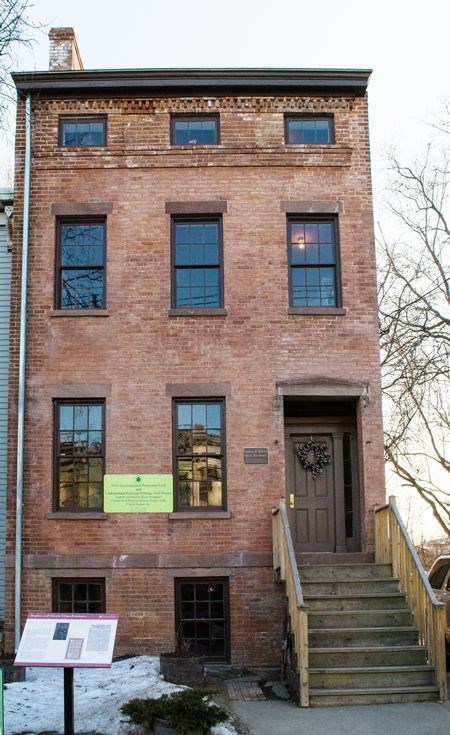Last updated: February 23, 2021
Article
New York: The Stephen and Harriet Myers Residence

Hudson River Valley Heritage Area.
The Stephen and Harriet Myers Residence was the mid-1850s office of the Vigilance Committee of Albany. This group, composed of Black abolitionists, was active in the underground railroad from the early 1840s up into the Civil War and assisted hundreds of freedom seekers in their pursuit of freedom in the northern United States and Canada.
Albany was a critical link on the trail northward, and the Vigilance Committee was the primary group for assisting freedom seekers to settle in or continue through Albany to other locations of safety. Sydney Howard Gay’s Record of Fugitives, housed in Columbia University’s Rare books and Manuscripts Collection, identifies 50 freedom seekers directed to receive services from Stephen Myers at today’s 194 Livingston Avenue. Letters from Stephen Myers and from Harriet Myers to members of the prominent New York family descended from John Jay indicate an ongoing relationship with Stephen and Harriet Myers that included directing freedom seekers to them in Albany and providing philanthropic support of their anti-slavery work.
According to letters and editorials written by Stephen Myers and preserved in such sources as Black Abolitionists written by Benjamin Quarles, Black Abolitionist Papers compiled by C. Peter Ripley, The Northern Star and Freeman’s Advocate newspaper, the Northern Star and Colored Farmer newspaper, and letters to members of the Jay family, Stephen Myers was involved in far more than his anti-slavery work. He was an active member of the New York State Suffrage Association, the American Council of Colored Laborers, he sued the City School District of Albany, New York in an effort to force the district to desegregate, and he organized The Florence Farming and Lumber Association, an economic development settlement for Black families located in central New York State. This is the man, along with wife Harriet, who is celebrated at the only extant building with which they have association, The Stephen and Harriet Myers Residence.
Stephen, born enslaved in Rensselaer County, New York and given his legal freedom in 1818, rose to the position of Chairman of the Vigilance Committee during the 1850s and became the most significant figure in Albany's Underground Railroad history, working in concert with other Black Albany residents on anti-slavery and civil rights initiatives. Myers actively assisted freedom seekers for nearly 30 years, beginning in 1831. According to the obituary of Harriet Myers following her death in 1865, published in The Christian Recorder out of Philadelphia, "during the many years her husband was devoted to the superintending of the underground railroad, she was kind and unremitting in her attendance on the unfortunate passengers... " In addition,"...she did perform much of the editorial labors upon the 'Northern Light' published some years since by Mr. Myers, and was entrusted with the reading of the proof sheets for its columns."
Myers' importance in the national movement was highlighted many years after emancipation, when author Wilbur Siebert, in his 1898 book, The Underground Railroad, said the following:
Frederick Douglass, who was familiar with this Albany route during the period of his residence in Rochester, described it as running through Philadelphia, New York, Albany, Rochester, and thence to Canada; and he gives the name of the person at each station that was most closely associated in his mind with the work of the station. Thus, he says that the "fugitives were received at Philadelphia by William Still, by him sent to New York, where they were cared for by Mr. David Ruggles, and afterwards by Mr. Gibbs, ... thence to Stephen Myers at Albany; thence to J. W. Logan, Syracuse; thence to Frederick Douglass, Rochester; and thence to Hiram Wilson, St. Catherines, Canada West.
In addition, Myers is cited frequently in newspapers of the 1840s and 1850s as a speaker and representative at multi-state Colored Men’s Conventions well beyond the Albany area, and often shared the podium with Frederick Douglass, both when Douglass spoke in Albany and in other locations.
Added to these factors is the fact that what is now known as The Stephen and Harriet Myers Residence was built and owned by John Johnson, a Black boat captain and Vigilance Committee member, who was a savvy enough and successful enough business man to be able to build in 1847 this 10 room, four story, Greek Revival home that includes medallions and gas lighting and other state-of-the-art features. This building stands as a tribute to the significant contributions of Black Americans to the health, wealth, and development of the city of Albany and communities around the country in the antebellum period, and it also is a symbol of the continuing struggle to insure equity and justice for Black Americans as we, today, continue to oppose the civil rights injustices against which our abolitionists forebears fought.
The Stephen and Harriet Myers Residence became part of the African American Civil Rights Network in February 2021.
The African American Civil Rights Network recognizes the civil rights movement in the United States and the sacrifices made by those who fought against discrimination and segregation. Created by the African American Civil Rights Act of 2017, and coordinated by the National Park Service, the Network tells the stories of the people, places, and events of the U.S. civil rights movement through a collection of public and private elements.
